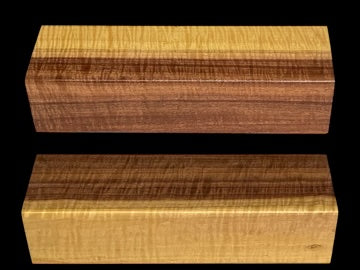
Mulga
Mulga refers to wood from the Acacia aneura species and its close relatives, a small tree or shrub native to arid and semi-arid regions of Australia, particularly across the outback in Western Australia, Queensland, New South Wales, and South Australia. Mulga trees typically grow to 5–10 metres tall with trunk diameters of 20–40 cm, often forming dense thickets or scattered stands in red sandy soils, where they dominate up to 70% of Australia’s arid interior. They are well-adapted to harsh conditions, with small, needle-like phyllodes (modified leaves) that reduce water loss.
The heartwood of Mulga is a rich, dark reddish-brown to deep chocolate brown, often with a golden or yellowish undertone when freshly cut, darkening with age. The sapwood is a pale cream or straw colour, sharply distinct. The grain is typically straight to slightly interlocked, with a very fine, even texture and a moderate natural lustre, giving it a smooth, polished look when finished. Mulga often exhibits subtle figuring, such as faint stripes or small knots, adding to its visual appeal, though it’s less dramatic than burl woods.
Mulga has a density of around 900–1,100 kg/m³, making it an extremely hard, heavy, and durable wood, with a Janka hardness often exceeding 3,000 lbf, comparable to some of the densest Australian hardwoods. It’s highly resistant to decay, termites, and wear, thanks to its natural oils and tight grain, making it suitable for both indoor and outdoor applications. The wood can be challenging to work due to its hardness and density, often blunting tools, and the interlocked grain may cause tearout during planing. It glues and finishes well, with oil-based finishes enhancing its warm tones, though its density may require pre-drilling for nails or screws.
When worked, Mulga has a mild, slightly spicy scent, typical of many acacias, with no overpowering aroma. In the UK, it’s often used for small, high-value items like knife handles, pen blanks, and turned objects such as bowls or spindles, where its durability and rich colour can be showcased. Indigenous Australians have long used Mulga for tools, weapons (e.g., boomerangs, spear-throwers), and fire-making, as its dense wood burns slowly and hot, leaving long-lasting embers. It’s also valued for fence posts and small furniture pieces in its native Australia due to its toughness.
Mulga is not listed on CITES Appendices, and Acacia aneura is considered of least concern by the IUCN, as it’s widespread and abundant in Australia’s arid zones. However, its availability in the UK is limited, often imported in small quantities as turning blanks or specialty lumber, making it moderately expensive. Its extreme hardness, rich colour, and cultural significance make Mulga a prized choice for craftsmen seeking a durable, characterful wood for bespoke projects.
